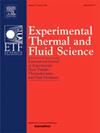利用可折叠管诱导的脉动流增强传热
IF 3.3
2区 工程技术
Q2 ENGINEERING, MECHANICAL
Experimental Thermal and Fluid Science
Pub Date : 2025-06-23
DOI:10.1016/j.expthermflusci.2025.111543
引用次数: 0
摘要
本研究探讨了利用可折叠管(CT)促进的简单被动脉动机制增强传热率。在不同雷诺数(Re)下,对可折叠管和刚性管进行了对比分析,了解脉动对热特性和流动特性的影响。结果表明,ct诱导的脉动显著提高了换热率,在较低的Re(581 ~ 1597)和相应的Strouhal数(Sr⪆0.2)下,换热率提高了70% ~ 50%。然而,在1597以上的高Re条件下,与刚性管相比,增强减弱,表现为较低的脉动频率(Sr = 0.15),从Re = 1742时的44%下降到Re = 2323时的23%。此外,还评估了热液性能指数(TPI),以量化可折叠管系统中相对于压力损失的传热效率。采用适当的正交分解(POD)分析方法提取关键流动结构并表征脉动动力学特征。POD结果表明,可折叠管的动力学特性在流场中引入了刚性管不存在的高能间歇相干结构,有助于增强混合和更有效的换热。这些发现表明,在不需要复杂的主动控制系统的情况下,在各种工程应用中,采用可折叠管提供了一种显着提高传热速率的实用策略。本文章由计算机程序翻译,如有差异,请以英文原文为准。
Heat transfer augmentation using collapsible tube-induced pulsating flow
This study investigates the enhancement of heat transfer rates using a simple passive pulsation mechanism facilitated by a collapsible tube (CT). A comparative analysis between the collapsible tube and a rigid tube is conducted at various Reynolds numbers () to understand the impact of pulsation on the thermal and flow characteristics. The results show that the CT-induced pulsation significantly enhances the heat transfer rate, with an observed increase ranging from 70% to 50% at lower (581 to 1597) with a corresponding Strouhal number (). However, the enhancement diminishes at higher beyond 1597, characterized by a lower pulsation frequency (), reducing from 44% at = 1742 to 23% at = 2323, as compared to the rigid tube case. Additionally, the thermohydraulic performance index (TPI) is assessed to quantify the efficiency of heat transfer rate relative to pressure losses in the collapsible tube system. Proper Orthogonal Decomposition (POD) analysis is employed to extract key flow structures and characterize the pulsation dynamics. The POD results reveal that the dynamic behaviour of the collapsible tube introduces energetic intermittent coherent structures in the flow field, which are absent in the rigid tube case, contributing to enhanced mixing and more efficient heat transfer. These findings suggest that employing a collapsible tube offers a practical strategy for significantly improving the heat transfer rate in various engineering applications without the need for complex active control systems.
求助全文
通过发布文献求助,成功后即可免费获取论文全文。
去求助
来源期刊

Experimental Thermal and Fluid Science
工程技术-工程:机械
CiteScore
6.70
自引率
3.10%
发文量
159
审稿时长
34 days
期刊介绍:
Experimental Thermal and Fluid Science provides a forum for research emphasizing experimental work that enhances fundamental understanding of heat transfer, thermodynamics, and fluid mechanics. In addition to the principal areas of research, the journal covers research results in related fields, including combined heat and mass transfer, flows with phase transition, micro- and nano-scale systems, multiphase flow, combustion, radiative transfer, porous media, cryogenics, turbulence, and novel experimental techniques.
 求助内容:
求助内容: 应助结果提醒方式:
应助结果提醒方式:


